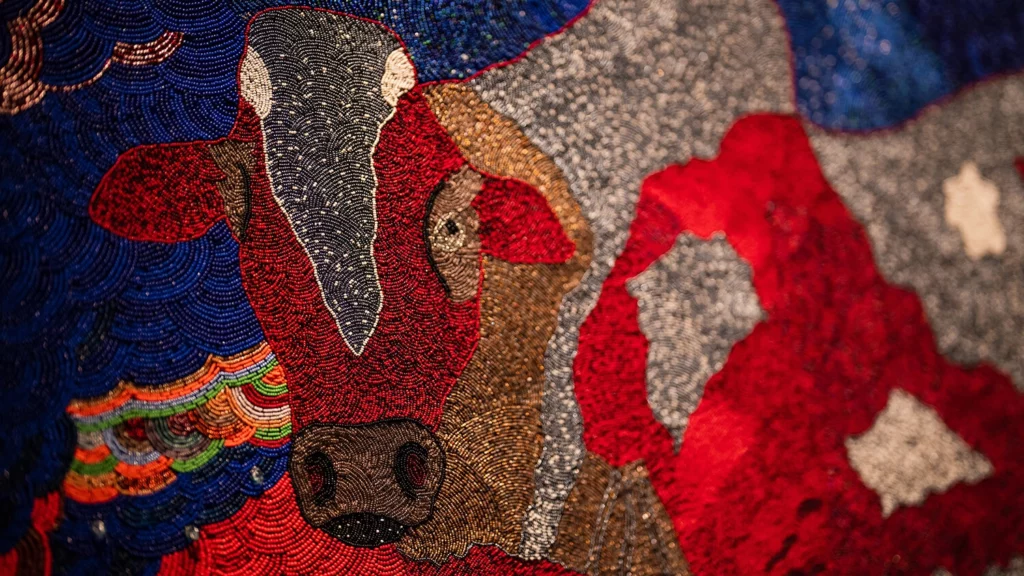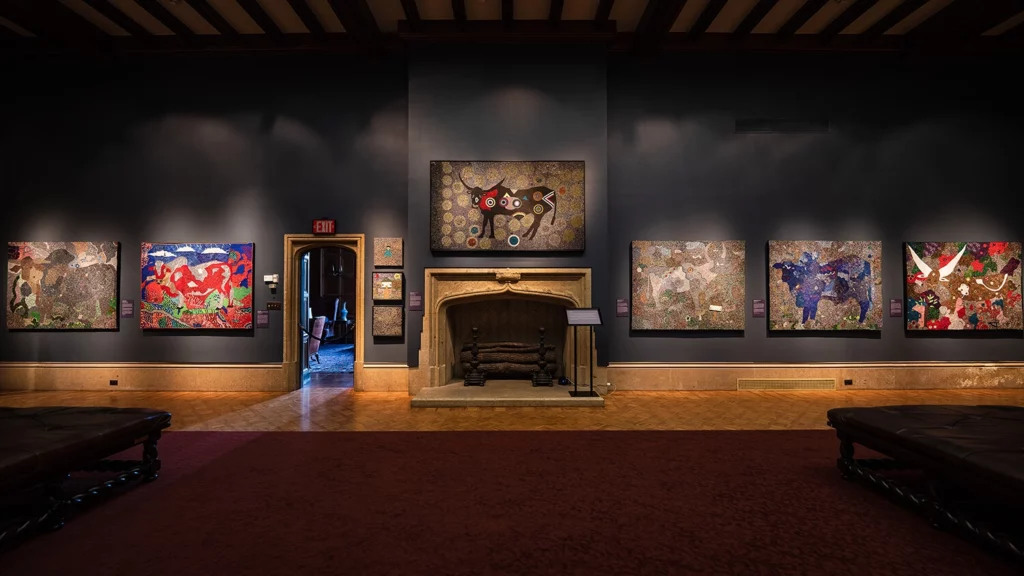 Ken Cravillion
Ken Cravillion Ubuhle Women: Beadwork and the Art of Independence
February 19 – May 22, 2022
Ubuhle Women: Beadwork and the Art of Independence showcases a new form of bead art, the “ndwango,” developed by a community of women living and working together in rural KwaZulu-Natal, South Africa.
About the Exhibition
The black fabric on which the Ubuhle women work is reminiscent of the Xhosa headscarves and skirts which many of them grew up wearing. Stretching this textile like a canvas, artists can transform the flat cloth into a contemporary art form with colored Czech glass beads. Using skills handed down through generations, and working in their own unique style “directly from the soul,” according to artist Ntombephi Ntobela, the women create abstract as well as figurative subjects for their ndwangos.
Ubuhle means “beauty” in the Xhosa and Zulu languages and it describes the shimmering quality of light on glass that for the Xhosa people has a particular spiritual significance. From a distance, each panel seems to be formed from a continuous surface, but as each tiny individual bead catches the light, the viewer becomes aware of the meticulous skill that went into each work and the scale of ambition: a single panel can take more than 10 months to complete.
Migration has defined the history of modern South Africa. The late-19th-century discovery of gold and diamonds—and, to a lesser extent, the cultivation of sugar cane—transfigured South African society with its demands for a large, flexible workforce of able men. As workers left their homesteads in rural areas to earn cash salaries, traditional social systems based on direct production from the land began to change. Low pay and harsh working conditions forced many cane cutters to live apart from their wives and families for up to nine months of the year, which led to a breakdown of family life and traditional values.
Ubuhle was conceived in response to this social and cultural transformation. Established in 1999 by two women—Ntombephi “Induna” Ntobela and Bev Gibson—on a former sugar plantation, Ubuhle began as a way of creating employment for rural women by combining traditional skills and making them profitable. By incorporating a skill that many local women already had—beadwork, a customary form of artistic expression for generations of South African women—and teaching it to those who did not, they began to provide women with a private source of income and a route to financial independence.
Since 2006, the Ubuhle community has lost five artists to HIV/AIDS and other illnesses, nearly halving the number of active artists. Many of the ndwangos thus function as memorials to Ubuhle sisters who have lost their lives. Remembering the dead is a key motivation for the creation of many of these artworks, and it imbues them with a spiritual significance.
Due to the slow, meticulous process of creating a ndwango, the act of beading itself becomes a form of therapy: a way of setting down the issues that are closest to the artists’ hearts; a way of grieving; and a place to encode feelings and memories. In a sense—through their presence in the artists’ thoughts during the act of creation—the deceased enter the very fabric of the work, and so the ndwango becomes a site of memory.
Sponsored by
Lead Sponsor

Partnering Sponsor

Organized for tour by

Ubuhle Women: Beadwork and the Art of Independence was developed by the Smithsonian Anacostia Community Museum, Washington, DC in cooperation with Curators Bev Gibson, Ubuhle Beads, and James Green, and is organized for tour by International Arts & Artists, Washington, DC.
Become a Member Now!
The best way to experience Ubuhle Women: Beadwork and the Art of Independence and all the offerings of the Paine is by becoming a Member. You’ll receive free admission to the exhibition, discounted reservations and purchases, and invitations to educational programs and special events for an entire year!



